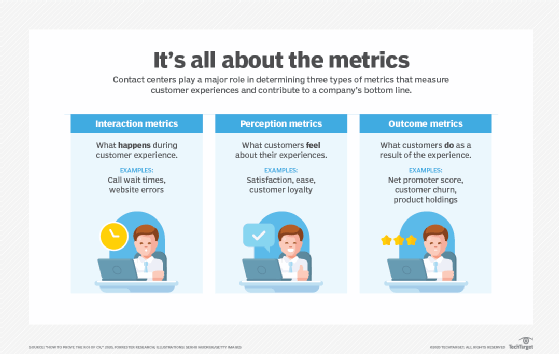8 contact center metrics to improve agent performance and CX
These metrics measure and report on productivity and effectiveness at the contact center agent level to ensure performance aligns with the overall mission of the organization.
The key to a contact center's success is having agents who can work with customers to resolve their issues efficiently and effectively. Organizations must measure and report contact center agents' productivity and effectiveness to ensure they perform against expected standards and goals in support of the overall mission of the contact center.
Contact centers monitor a broad set of KPIs that can be reported by a variety of contact center software platforms, including multichannel contact routing, workforce management, quality monitoring and speech analytics. Contact center KPIs can be measured at the department, team and agent level.
When identifying potential contact center metrics to measure performance at the agent level, contact center management should consider the following two questions:
- Can the agent control the metric? Agents should be measured on metrics they can control. That is why metrics like average speed of answer and service level aren't good indicators of agent productivity. Too many other factors, outside of an agents' control, such as the volume of customer calls, incoming call patterns and scheduling accuracy can affect these metrics.
- Does holding the agent accountable for a metric create behavior that's not in the customer's best interest? For example, if there is too much focus on a metric such as an agent's average handle time, it might drive agents to rush calls and not resolve a customer's issue adequately. This has a direct negative effect on customer satisfaction and the overall customer experience.

What are contact center metrics and why are they valuable?
Contact centers should use a balanced scorecard to measure productivity and quality when analyzing agent performance. Contact center management can use the following list of metrics to measure and report contact center agent performance.
1. Average handle time
Average handle time (AHT) refers to the amount of time an agent spends interacting with a customer during a call and is a measurement of productivity. As noted earlier, if management places too much emphasis on AHT, it might cause agents to rush callers off the phone before their issue is resolved. It's critical to identify agents who are outliers of the contact center's average AHT, either higher or lower, to ensure those agents are effectively handling customer interactions and driving an outstanding customer experience. To dig deeper and identify specific opportunities, contact center leadership should monitor and analyze three key components of AHT:
- Average talk time. Average talk time measures the amount of time an agent speaks with a caller. The length of individual phone calls might vary significantly, but, over time, settles to an average and expected range. Leadership should analyze agents whose average talk time deviates from the contact center's average, both high and low. The results from a quality assurance/monitoring program can be used to determine whether an agent rushes callers off the phone without resolving their issues, resulting in a lower talk time, or if they struggle to control the call's flow or to use desktop tools, resulting in a higher talk time.
- Average hold time. Average hold time measures how much time callers spend on hold listening to dead air, announcements or music. If agents place callers on hold often and for extended periods, they might be researching the answers to callers' questions or struggling to navigate among multiple systems. Additional training, improved access to resources and simpler systems integration can help resolve these challenges. In general, customers don't like to be placed on hold for an extended time and might become frustrated with the customer service experience.
- Average after-call work time. Average after-call work time measures how much time an agent spends performing follow-up tasks -- such as typing notes and sending emails -- after they complete a call. Improving processes by providing templates for emails and providing AI technology that auto-generates case notes -- could help to reduce after-call work time.
2. Quality monitoring
Quality monitoring occurs when a quality assurance team or supervisors listen to agent phone calls and score them on multiple factors, including customer interaction, problem resolution, and adherence to policy and procedure. The most effective quality monitoring programs use automated call monitoring software that supports both the recording of the audio portion of the call and the recording of the screens used by the contact center agent. Quality monitoring results might not fully correlate to customer satisfaction, but the results can identify where agents might require coaching, feedback and additional training to reach proficiency. The following two critical elements of quality monitoring can be further used to identify where agents might require additional training:
- Call control. During call monitoring, the quality analyst or supervisor should determine how well the agent controlled the flow of the telephone call. Some difficult calls might require more time, which is fine if the agent needs the time to resolve the caller's issue. If an agent controls the call's flow well, AHT is usually lower, which improves efficiency. It's critical for agents to invest time and interact with empathy and connect with a customer during a call, but there needs to be a balance to ensure the conversation follows an efficient flow.
- First contact resolution. During call monitoring, the quality analyst or supervisor should determine whether an agent did everything within their power to resolve a caller's issue. Sometimes, an agent can't fully resolve a caller's issue because of policy and procedure. At times, a caller might have to call back with additional information before their issue can be resolved. From a departmental perspective, this initial call wouldn't be categorized as first contact resolution. Yet, from the agent's perspective, everything was done correctly.
3. Customer satisfaction
Post-call surveys can be used to track customer satisfaction. Customer satisfaction scores should focus on the key elements of the customer interaction with the agent, such as politeness, courtesy and effectiveness, which are within an agent's control. If management teams can dissect customer satisfaction scores at a more granular level -- by call type, for example -- they might discover opportunities to provide additional agent training to handle specific call types.
Net Promoter Score can also be used as a measure of customer satisfaction, but the results might reflect satisfaction with items in addition to a contact center interaction.
4. Contact center schedule adherence
Contact center schedule adherence measures how well agents adhere to their schedules. For this metric, management should use contact center software that tracks whether agents arrive and leave on time and take their scheduled breaks. When agents adhere to their schedules, they can contribute to the department by meeting critical service-level agreements, such as average speed of answer and service level.
5. Dial transfer rate
The dial transfer rate measures how often an agent passes interactions to other individuals or departments. It might be a struggle to identify a target for this KPI, as policy and procedure drive many dial transfers. Like other metrics, management teams should identify agents who are outliers to the average to determine whether they require additional training or call monitoring.
6. Unavailable time
Unavailable time is when agents place themselves in a status where they can't answer incoming calls. Monitoring unavailable time is used to identify when agents are unavailable to work with customers, yet management expects their availability. This metric must exclude approved unavailable time such as break times or training periods. Contact center leadership should set a predefined amount of allowable unavailable time for agents and agents should be monitored to ensure they don't abuse this time.
7. Agent occupancy
Agent occupancy measures the time agents are on calls or perform after-call work during their shifts.
Agent occupancy isn't a performance metric because many items outside of the agent's control can affect it, such as call flow and volume. Instead, management teams can use agent occupancy as an indicator of burnout. High occupancy levels -- more than 85%, for example -- indicate that continuous phone calls might be overwhelming agents, leading to reduced efficiency and increased turnover.
8. Agent absenteeism
Agent absenteeism measures the amount of time agents are out of the office for unplanned reasons. A baseline amount of absenteeism should be expected, but once that level is exceeded, additional resources will be required to properly staff the contact center. Creative scheduling can help with absenteeism, such as adjusting an agent's schedule to fix a daycare issue instead of the agent not coming to work. While an agent should never be punished for a legitimate absence, high levels of absenteeism can be an indicator of employee dissatisfaction.
When management teams properly monitor and analyze contact center agent performance, these metrics can provide a balanced evaluation and ensure agents are effectively resolving customer issues in a cost-effective manner. Appropriate follow-ups can occur after management analyzes the metrics and identifies performance improvement opportunities. Follow-up activities include coaching, training and recognition to ensure performance gaps are addressed and outstanding results are rewarded.
By using the proper metrics, contact center management can ensure agent performance aligns with the overall mission of the contact center.
Scott Sachs is president and founder of SJS Solutions, a consultancy that specializes in contact center strategy assessments and technology selection.








